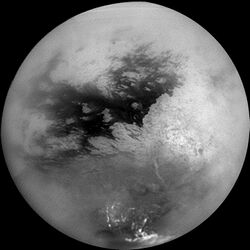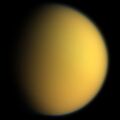Engineering:Dragonfly (spacecraft)
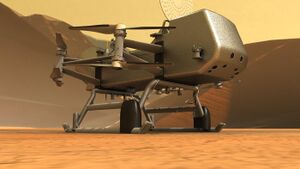 Spacecraft concept illustration | |
| Mission type | Rotorcraft on Titan |
|---|---|
| Operator | NASA |
| Website | dragonfly |
| Mission duration | 10 years (planned)[1] Science phase: 3.3 years[2] |
| Spacecraft properties | |
| Spacecraft type | Rotorcraft lander |
| Manufacturer | Applied Physics Laboratory |
| Landing mass | ≈450 kg (990 lb)[3] |
| Power | 70 watts (desired)[3] from an MMRTG |
| Start of mission | |
| Launch date | July 2028 (planned)[4] |
| Rocket | TBA |
| Invalid value for parameter "type" | |
| Invalid parameter | 2034[2] |
| "location" should not be set for flyby missions | Shangri-La dune fields[5] |
| "distance" should not be set for missions of this nature | 8 km (5.0 mi) per flight (planned)[5] |
| Instruments | |
| Dragonfly Mass Spectrometer (DraMS) Dragonfly Gamma-Ray and Neutron Spectrometer (DraGNS) Dragonfly Geophysics and Meteorology Package (DraGMet) | |
 Dragonfly Mission Insignia | |
Dragonfly is a planned spacecraft and NASA mission to send a robotic rotorcraft to the surface of Titan, the largest moon of Saturn. It is planned to be launched in July 2028. It would be the first aircraft on Titan and is intended to make the first powered and fully controlled atmospheric flight on any moon, with the intention of studying prebiotic chemistry and extraterrestrial habitability. It would then use its vertical takeoffs and landings (VTOL) capability to move between exploration sites.[6][7][8]
Titan is unique in having an abundant, complex, and diverse carbon-rich chemistry and a surface dominated by water and ice, with an interior water ocean, making it a high-priority target for astrobiology and origin of life studies.[6] The mission was proposed in April 2017 to NASA's New Frontiers program by the Johns Hopkins Applied Physics Laboratory (APL), and was selected as one of two finalists (out of twelve proposals) in December 2017 to further refine the mission's concept.[9][10] On 27 June 2019, Dragonfly was selected to become the fourth mission in the New Frontiers program.[11][12]
Overview
Dragonfly is an astrobiology mission to Titan to assess its microbial habitability and study its prebiotic chemistry at various locations. Dragonfly is designed to perform controlled flights and vertical takeoffs and landings between locations. The mission is to involve flights to multiple different locations on the surface, which allows sampling of diverse regions and geological contexts.[3][13]
Titan is a compelling astrobiology target because its surface contains abundant complex carbon-rich chemistry and because both liquid water (transient) and liquid hydrocarbons can occur on its surface, possibly forming a prebiotic primordial soup.[14]
A successful flight of Dragonfly would make it the second rotorcraft to fly on a celestial body other than Earth, following the success of Ingenuity, a technology demonstration UAV helicopter, which landed on Mars with the Perseverance rover on 18 February 2021 as part of the Mars 2020 mission and successfully achieved powered flight on 19 April 2021.[15][16][17]
History
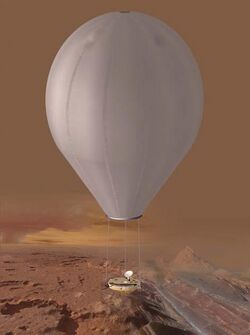
The initial Dragonfly conception took place over a dinner conversation between scientists Jason W. Barnes of Department of Physics, University of Idaho, (who had previously made the AVIATR proposal for a Titan aircraft) and Ralph Lorenz of Johns Hopkins University Applied Physics Laboratory, and it took 15 months to make it a detailed mission proposal.[18] The principal investigator is Elizabeth Turtle, a planetary scientist at the Johns Hopkins Applied Physics Laboratory.[13]
The Dragonfly mission builds on several earlier studies of Titan mobile aerial exploration, including the 2007 Titan Explorer Flagship study,[19] which advocated a Montgolfier balloon for regional exploration, and AVIATR, an airplane concept considered for the Discovery program.[3] The concept of a rotorcraft lander that flew on battery power, recharged during the 8-Earth-day Titan night from a radioisotope power source, was proposed by Lorenz in 2000.[20] More recent discussion has included a 2014 Titan rotorcraft study by Larry Matthies, at the Jet Propulsion Laboratory, that would have a small rotorcraft deployed from a lander or a balloon.[21] The hot-air balloon concepts would have used the heat from a radioisotope thermoelectric generator (RTG).[22]
Dragonfly is to use its multi-rotor vehicle to transport its instrument suite to multiple locations to make measurements of surface composition, atmospheric conditions, and geologic processes.[23]
Dragonfly and CAESAR, a comet sample return mission to 67P/Churyumov–Gerasimenko, were the two finalists for the New Frontiers program Mission 4,[24][25] and on 27 June 2019, NASA selected Dragonfly for development with a plan to launch in June 2027.[26][27]
On 3 March 2023, Dragonfly passed its preliminary design review (PDR).[28]
In November 2023 following NASA's decision to postpone the formal confirmation of the mission due to funding uncertainties, the launch was delayed by one year, with a new launch date set for July 2028.[4]
Funding
The CAESAR and Dragonfly missions received US$4 million funding each through the end of 2018 to further develop and mature their concepts.[24] NASA announced the selection of Dragonfly on 27 June 2019, which is expected to be built and launched by July 2028.[4] Dragonfly is the fourth in NASA's New Frontiers portfolio, a series of principal investigator-led planetary science investigations that fall under a development cost cap of approximately US$850 million, and including launch services, the total cost projection is approximately US$1 billion.[29]
Science objectives
Titan is similar to the very early Earth, and can provide clues to how life may have arisen on Earth. In 2005, the European Space Agency's Huygens lander acquired some atmospheric and surface measurements on Titan, detecting tholins,[30] which are a mix of various types of hydrocarbons (organic compounds) in the atmosphere and on the surface.[31][32] Because Titan's atmosphere obscures the surface at many wavelengths, the specific compositions of solid hydrocarbon materials on Titan's surface remain essentially unknown.[33] Measuring the compositions of materials in different geologic settings is intended to reveal how far prebiotic chemistry has progressed in environments that provide known key ingredients for life, such as pyrimidines (bases used to encode information in DNA) and amino acids, the building blocks of proteins.[34]
Areas of particular interest are sites where extraterrestrial liquid water in impact melt or potential cryovolcanic flows may have interacted with the abundant organic compounds. Dragonfly would provide the capability to explore diverse locations to characterize the habitability of Titan's environment, investigate how far prebiotic chemistry has progressed, and search for biosignatures indicative of life based on water as solvent and even hypothetical types of biochemistry.[6]
The atmosphere contains plentiful nitrogen and methane, and strong evidence indicates that liquid methane exists on the surface. Evidence also indicates the presence of liquid water and ammonia under the surface, which may be delivered to the surface by cryovolcanic activity.[35]
Design and construction

Dragonfly is designed as a rotorcraft lander, much like a large quadcopter with double rotors, which is known as an octocopter.[3] The rotor configuration provides redundancy to enable the mission to tolerate the loss of at least one rotor or motor.[3] Each of the craft's eight rotors is to be about 1 m (3.3 ft) in diameter.[3] The aircraft would travel at about 10 m/s (36 km/h; 22 mph) and climb to an altitude of up to 4 km (13,000 ft).[3]
Flight on Titan is aerodynamically benign as Titan has low gravity and little wind, and its dense atmosphere allows for efficient rotor propulsion.[36] The radioisotope thermoelectric generator (RTG) power source has been proven in multiple spacecraft, and the extensive use of quad drones on Earth provides a well-understood flight system that is being complemented with algorithms to enable independent actions in real-time.[36] The craft is designed to operate in a space radiation environment and in temperatures averaging 94 K (−179.2 °C).[36]
Titan's dense atmosphere and low gravity mean that the flight power for a given mass is a factor of about 40 times lower than on Earth.[3] The atmosphere has 1.45 times the pressure and about four times the density of Earth's, and local gravity (13.8% of Earth's) makes flight easier than on Earth, although cold temperatures, lower light levels and higher atmospheric drag on the airframe will be challenges.[22]
Dragonfly should be able to fly several kilometers,[37] powered by a lithium-ion battery, which is to be recharged by a Multi-Mission Radioisotope Thermoelectric Generator (MMRTG) during the night.[20] MMRTGs convert the heat from the natural decay of a radioisotope into electricity.[3] Twenty-four Radioisotope Heater Units (RHUs) are also kept reserved for this mission.[38] The rotorcraft should be able to travel ten miles (16 km) on each battery charge and stay aloft for a half hour each time.[39] The vehicle is to have sensors to scout new science targets, and then return to the original site until new landing destinations are approved by mission controllers.[39][40]
The Dragonfly rotorcraft will weigh approximately 450 kg (990 lb) and be packaged inside a heatshield of 3.7 m (12 ft) diameter.[3] Regolith samples are to be obtained by two sample acquisition drills and hoses, one on each landing skid, for delivery to the mass spectrometer instrument.[3]
The craft is to remain on the ground during the Titan nights, which last about 8 Earth days or 192 hours.[3] Activities during the night may include sample collection and analysis, seismological studies like diagnosing wave activity on the northern hydrocarbon seas,[41] meteorological monitoring, and local microscopic imaging using LED illuminators as flown on Phoenix lander and Curiosity rover.[3][42] The craft is designed to communicate directly to Earth with a high-gain antenna.[3]
The Penn State Vertical Lift Research Center of Excellence is responsible for rotor design and analysis, rotorcraft flight-control development, scaled rotorcraft testbed development, ground testing support, and flight performance assessment.[43]
Scientific payload
- DraMS (Dragonfly Mass Spectrometer) is a mass spectrometer to identify chemical components, especially those relevant to biological processes, in surface and atmospheric samples.[18]
- DraGNS (Dragonfly Gamma-Ray and Neutron Spectrometer), consists of a deuterium-tritium Pulsed Neutron Generator and a set of a gamma-ray spectrometer and neutron spectrometer to identify the surface composition under the lander.[18]
- DraGMet (Dragonfly Geophysics and Meteorology Package) is a suite of meteorological sensors including a seismometer.[18]
- DragonCam (Dragonfly Camera Suite) is a set of microscopic and panoramic cameras to image Titan's terrain and scout for scientifically interesting landing sites.[18]
- In addition, Dragonfly is to have multiple engineering and monitoring instruments to determine characteristics of Titan's interior and atmosphere.[18]
Trajectory
Dragonfly is expected to launch in July 2028[44] and to take seven years to reach Titan, arriving by 2034.[45][46] The spacecraft is likely to perform a gravity assist flyby of Earth to gain additional velocity on its way to Titan.[47] The spacecraft would be the first dedicated outer solar system mission to not visit Jupiter, as it will not be within the flight path.[48]
Entry and descent
The cruise stage is to separate from the entry capsule ten minutes before encountering Titan's atmosphere.[39] The lander would then descend to the surface of Titan using an aeroshell and a series of two parachutes, while the spent cruise stage would burn up in uncontrolled atmospheric entry. The duration of the descent phase is expected to be 105 minutes.[49] The aeroshell is derived from the Genesis sample return capsule, and the PICA heat shield is similar to MSL and Mars 2020 design and should protect the spacecraft for the first six minutes of its descent.[49]
At a speed of Mach 1.5, a drogue parachute is to deploy, to slow the capsule to subsonic speeds. Due to Titan's comparatively thick atmosphere and low gravity, the drogue chute phase should last for 80 minutes.[49] A larger main parachute is to replace the drogue chute when the descent speed is sufficiently low. During the 20 minutes on the main chute, the lander is to be prepared for separation. The heat shield is to be jettisoned, the landing skids are to be extended, and sensors such as radar and lidar are to be activated.[49] At an altitude of 1.2 km (0.75 mi), the lander should be released from its parachute for a powered flight to the surface. The specific landing site and flight operation are to be performed autonomously. This is required since the high gain antenna would not be deployed during descent, and because communication between Earth and Titan takes 70–90 minutes in each direction.[39]
Landing site
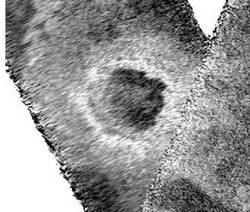
The Dragonfly rotorcraft should land initially in dunes to the southeast of the Selk impact structure at the edge of the dark region called Shangri-La.[51][5] It is planned to explore this region in a series of flights of up to 8 km (5.0 mi) each, and acquire samples from compelling areas with a diverse geography. After landing, it is planned to travel to the Selk impact crater, where in addition to tholin organic compounds, there is evidence of past liquid water.[5]
The Selk crater is a geologically young impact crater 90 km (56 mi) in diameter, located about 800 km (500 mi) north-northwest of the Huygens lander.[52] ( [ ⚑ ] 7°00′N 199°00′W / 7.0°N 199.0°W)[53][50] Infrared measurements and other spectra by the Cassini orbiter show that the adjacent terrain exhibits a brightness suggestive of differences in thermal structure or composition, possibly caused by cryovolcanism generated by the impact – a fluidized ejecta blanket and fluid flows, now water ice.[52][54] Such a region featuring a mix of organic compounds and water ice is a compelling target to assess how far the prebiotic chemistry may have progressed at the surface.[5]
See also
- Astronomy:Atmosphere of Titan – Thick atmospheric layers of Saturn's moon Titan
- Engineering:AVIATR – A mission concept of a Titan aircraft.
- Ingenuity – A rotorcraft that flew as part of Mars 2020 in April 2021.
- Engineering:CAESAR (spacecraft) – Proposed sample-return mission to a comet, other New Frontiers 4 finalist.
- Huygens (spacecraft) – European reconnaissance lander sent to Saturn's moon Titan.
- Astronomy:Titan Saturn System Mission – Joint NASA–ESA proposal
- Oceanus (Titan orbiter) – A Titan orbiter, also proposed for New Frontiers 4.
- Mars Aerial and Ground Global Intelligent Explorer - Mars solar aircraft concept
References
- ↑ Talbert, Tricia (2020-09-25). "Dragonfly Launch Moved to 2027". http://www.nasa.gov/feature/dragonfly-launch-moved-to-2027.
- ↑ 2.0 2.1
 One or more of the preceding sentences incorporates text from a work now in the public domain: "OPAG August 2021". Zibi Turtle, Dragonfly PI, JHUAPL. 31 August 2021. https://www.lpi.usra.edu/opag/meetings/aug2021/presentations/Turtle.pdf.
One or more of the preceding sentences incorporates text from a work now in the public domain: "OPAG August 2021". Zibi Turtle, Dragonfly PI, JHUAPL. 31 August 2021. https://www.lpi.usra.edu/opag/meetings/aug2021/presentations/Turtle.pdf.
- ↑ 3.00 3.01 3.02 3.03 3.04 3.05 3.06 3.07 3.08 3.09 3.10 3.11 3.12 3.13 3.14 Dragonfly: A Rotorcraft Lander Concept for Scientific Exploration at Titan Ralph D. Lorenz, Elizabeth P. Turtle, Jason W. Barnes, Melissa G. Trainer, Douglas S. Adams, Kenneth E. Hibbard, Colin Z. Sheldon, Kris Zacny, Patrick N. Peplowski, David J. Lawrence, Michael A. Ravine, Timothy G. McGee, Kristin S. Sotzen, Shannon M. MacKenzie, Jack W. Langelaan, Sven Schmitz, Larry S. Wolfarth, and Peter D. Bedini. 2018. Johns Hopkins APL Technical Digest, 34(3), 374-387
- ↑ 4.0 4.1 4.2 Foust, Jeff (28 November 2023). "NASA postpones Dragonfly review, launch date". SpaceNews.com. https://spacenews.com/nasa-postpones-dragonfly-review-launch-date/.
- ↑ 5.0 5.1 5.2 5.3 5.4
 One or more of the preceding sentences incorporates text from a work now in the public domain: NASA's Dragonfly Will Fly Around Titan Looking for Origins, Signs of Life Grey Hautaluoma and Alana Johnson NASA Press release 27 June 2019
One or more of the preceding sentences incorporates text from a work now in the public domain: NASA's Dragonfly Will Fly Around Titan Looking for Origins, Signs of Life Grey Hautaluoma and Alana Johnson NASA Press release 27 June 2019
- ↑ 6.0 6.1 6.2 Dragonfly: Exploring Titan's Prebiotic Organic Chemistry and Habitability E. P. Turtle, J. W. Barnes, M. G. Trainer, R. D. Lorenz, S. M. MacKenzie, K. E. Hibbard, D. Adams, P. Bedini, J. W. Langelaan, K. Zacny, and the Dragonfly Team Lunar and Planetary Science Conference 2017
- ↑ "Dragonfly: Titan Rotorcraft Lander". The Johns Hopkins University Applied Physics Laboratory. 2017. http://dragonfly.jhuapl.edu/.
- ↑ Redd, Nola Taylor (25 April 2017). ""Dragonfly" Drone Could Explore Saturn Moon Titan". SPACE.com. https://www.space.com/36598-dragonfly-quadcopter-saturn-moon-titan-explorer.html.
- ↑
 One or more of the preceding sentences incorporates text from a work now in the public domain: "NASA Invests in Concept Development for Missions to Comet, Saturn Moon Titan". NASA Solar System Exploration. NASA. 20 December 2017. https://www.nasa.gov/press-release/nasa-invests-in-concept-development-for-missions-to-comet-saturn-moon-titan/.
One or more of the preceding sentences incorporates text from a work now in the public domain: "NASA Invests in Concept Development for Missions to Comet, Saturn Moon Titan". NASA Solar System Exploration. NASA. 20 December 2017. https://www.nasa.gov/press-release/nasa-invests-in-concept-development-for-missions-to-comet-saturn-moon-titan/.
- ↑ "Dragonfly And CAESAR: NASA Greenlights Concepts For Missions To Titan And Comet 67P/Churyumov-Gerasimenko". 20 December 2017. http://www.science20.com/news_staff/dragonfly_and_caesar_nasa_greenlights_concepts_for_missions_to_titan_and_comet_67pchuryumovgerasimenko-229350.
- ↑
 One or more of the preceding sentences incorporates text from a work now in the public domain: Bridenstine, Jim (27 June 2019). "New Science Mission to Explore Our Solar System". https://twitter.com/JimBridenstine/status/1144334797101260800.
One or more of the preceding sentences incorporates text from a work now in the public domain: Bridenstine, Jim (27 June 2019). "New Science Mission to Explore Our Solar System". https://twitter.com/JimBridenstine/status/1144334797101260800.
- ↑ Brown, David W. (27 June 2019). "NASA Announces New Dragonfly Drone Mission to Explore Titan – The quadcopter was selected to study the moon of Saturn after a "Shark Tank"-like competition that lasted two and a half years". The New York Times. https://www.nytimes.com/2019/06/27/science/nasa-titan-dragonfly-caesar.html.
- ↑ 13.0 13.1 NASA Selects Johns Hopkins APL-Led Mission to Titan for Further Development Johns Hopkins Applied Physics Laboratory - Press release 21 December 2017
- ↑ Dragonfly: Exploring Titan's Surface with a New Frontiers Relocatable Lander American Astronomical Society, DPS meeting #49, id.219.02, October 2017
- ↑
 One or more of the preceding sentences incorporates text from a work now in the public domain: Renstrom, Joelle (27 December 2020). "NASA's Dragonfly Mission Will Seek Clues about Titan's Habitability". NASA. https://astrobiology.nasa.gov/news/nasas-dragonfly-mission-will-seek-clues-about-titans-habitability/.
One or more of the preceding sentences incorporates text from a work now in the public domain: Renstrom, Joelle (27 December 2020). "NASA's Dragonfly Mission Will Seek Clues about Titan's Habitability". NASA. https://astrobiology.nasa.gov/news/nasas-dragonfly-mission-will-seek-clues-about-titans-habitability/.
- ↑
 One or more of the preceding sentences incorporates text from a work now in the public domain: Agle, David; Johnson, Alana; Hautaluoma, Grey (19 February 2021). "NASA's Mars Helicopter Reports In". Jet Propulsion Laboratory. NASA. https://www.jpl.nasa.gov/news/nasas-mars-helicopter-reports-in.
One or more of the preceding sentences incorporates text from a work now in the public domain: Agle, David; Johnson, Alana; Hautaluoma, Grey (19 February 2021). "NASA's Mars Helicopter Reports In". Jet Propulsion Laboratory. NASA. https://www.jpl.nasa.gov/news/nasas-mars-helicopter-reports-in.
- ↑ Johnson, Alana; Hautaluoma, Grey; Agle, DC (19 April 2021). "NASA's Ingenuity Mars Helicopter Succeeds in Historic First Flight". in Northon, Karen. https://www.nasa.gov/press-release/nasa-s-ingenuity-mars-helicopter-succeeds-in-historic-first-flight.
- ↑ 18.0 18.1 18.2 18.3 18.4 18.5 Lorenz, Ralph; Turtle, Elizabeth; Barnes, Jason; Trainer, Melissa; Adams, Douglas; Hibbard, Kenneth; Sheldon, Colin; Zacny, Kris et al.. "Dragonfly: A Rotorcraft Lander Concept for Scientific Exploration at Titan". Johns Hopkins University. https://dragonfly.jhuapl.edu/News-and-Resources/docs/34_03-Lorenz.pdf.
- ↑
 One or more of the preceding sentences incorporates text from a work now in the public domain: Titan Explorer - Flagship Study NASA and APL January 2008
One or more of the preceding sentences incorporates text from a work now in the public domain: Titan Explorer - Flagship Study NASA and APL January 2008
- ↑ 20.0 20.1 Post-Cassini Exploration of Titan: Science Rationale and Mission Concepts R. Lorenz, Journal of the British Interplanetary Society, 2000, Vol. 53, pages 218-234
- ↑
 One or more of the preceding sentences incorporates text from a work now in the public domain: NIAC Phase 1 Final Study Report on Titan Aerial Daughtercraft Larry Matthies NASA/JPL 2014
One or more of the preceding sentences incorporates text from a work now in the public domain: NIAC Phase 1 Final Study Report on Titan Aerial Daughtercraft Larry Matthies NASA/JPL 2014
- ↑ 22.0 22.1
 One or more of the preceding sentences incorporates text from a work now in the public domain: Montgolfiere Aerobots for Titan Jack A. Jones and Jiunn Jenq Wu NASA's Jet Propulsion Laboratory
One or more of the preceding sentences incorporates text from a work now in the public domain: Montgolfiere Aerobots for Titan Jack A. Jones and Jiunn Jenq Wu NASA's Jet Propulsion Laboratory
- ↑ Langelaan J. W. et al. (2017) Proc. Aerospace Conf. IEEE
- ↑ 24.0 24.1 Chang, Kenneth (20 November 2017). "Finalists in NASA's Spacecraft Sweepstakes: A Drone on Titan, and a Comet-Chaser". The New York Times. https://www.nytimes.com/2017/12/19/science/nasa-new-frontiers-finalists.html.
- ↑ Clark, Stuart (21 December 2017). "Spacewatch: out-of-this-world drone with a Titanic task ahead". The Guardian. https://www.theguardian.com/science/2017/dec/21/spacewatch-out-of-this-world-drone-with-a-titanic-task-ahead.
- ↑ "NASA New Frontiers 5: Third Community Announcement". NASA Science Mission Directorate. 12 May 2021. http://www.spaceref.com/news/viewsr.html?pid=54791.[yes|permanent dead link|dead link}}]
- ↑ Foust, Jeff (25 September 2020). "NASA delays Dragonfly launch by a year". SpaceNews. https://spacenews.com/nasa-delays-dragonfly-launch-by-a-year/.
- ↑ Talbert, Tricia (2023-03-24). "NASA's Dragonfly Team Soars through Major Design Review". https://www.nasa.gov/feature/nasa-s-dragonfly-team-soars-through-major-design-review.
- ↑
 One or more of the preceding sentences incorporates text from a work now in the public domain: Keeter, Bill (5 May 2017). "NASA Receives Proposals for Future Solar System Mission". NASA. https://solarsystem.nasa.gov/news/2017/05/05/nasa-receives-proposals-for-future-solar-system-mission.
One or more of the preceding sentences incorporates text from a work now in the public domain: Keeter, Bill (5 May 2017). "NASA Receives Proposals for Future Solar System Mission". NASA. https://solarsystem.nasa.gov/news/2017/05/05/nasa-receives-proposals-for-future-solar-system-mission.
- ↑ Sarah Hörst "What in the world(s) are tholins?" Planetary Society 23 July 2015 Retrieved 30 November 2016
- ↑ "Tropical Methane Lakes on Saturn's Moon Titan". Saturn Today. 2012. http://www.saturntoday.com/news/viewpr.html?pid=37429.
- ↑ New Images from the Huygens Probe: Shorelines and Channels, But an Apparently Dry Surface Emily Lakdawalla 15 January 2005 verified 28 March 2005
- ↑ Williams, Matt (25 August 2017). "Dragonfly Proposed to NASA as Daring New Frontiers Mission to Titan". Universe Today. https://www.universetoday.com/136935/dragonfly-proposed-nasa-daring-new-frontiers-mission-titan/.
- ↑ Kakaes, Konstantin (28 June 2019). "NASA announces plans to send a drone to explore Titan for signs of life". MIT Technology Review. https://www.technologyreview.com/2019/06/28/720/nasa-announces-plans-to-send-a-drone-to-explore-titan-for-signs-of-life/.
- ↑ Robert Zubrin The Case for Mars: The Plan to Settle the Red Planet and Why We Must p. 146, Simon & Schuster/Touchstone 1996 ISBN:978-0-684-83550-1
- ↑ 36.0 36.1 36.2 Turtle, Elizabeth P. (2019). "The Dragonfly Mission to Titan: Exploration of an Ocean World". JHU Applied Physics Laboratory. https://www.youtube.com/watch?v=G-OgzT5KO9o.
- ↑
 One or more of the preceding sentences incorporates text from a work now in the public domain: Northon, Karen (2019-06-27). "NASA's Dragonfly Mission to Titan Will Look for Origins, Signs of Life". NASA. http://www.nasa.gov/press-release/nasas-dragonfly-will-fly-around-titan-looking-for-origins-signs-of-life.
One or more of the preceding sentences incorporates text from a work now in the public domain: Northon, Karen (2019-06-27). "NASA's Dragonfly Mission to Titan Will Look for Origins, Signs of Life". NASA. http://www.nasa.gov/press-release/nasas-dragonfly-will-fly-around-titan-looking-for-origins-signs-of-life.
- ↑ Foust, Jeff (2023-05-03). "Plutonium availability constrains plans for future planetary missions" (in en-US). https://spacenews.com/plutonium-availability-constrains-plans-for-future-planetary-missions/.
- ↑ 39.0 39.1 39.2 39.3
 One or more of the preceding sentences incorporates text from a work now in the public domain: Talbert, Tricia (2019-12-26). "Dragonfly Frequently Asked Questions". NASA. http://www.nasa.gov/dragonfly/frequently-asked-questions/index.html.
One or more of the preceding sentences incorporates text from a work now in the public domain: Talbert, Tricia (2019-12-26). "Dragonfly Frequently Asked Questions". NASA. http://www.nasa.gov/dragonfly/frequently-asked-questions/index.html.
- ↑ Lorenz, Ralph (15 June 2018). "Sampling Titan's Diverse surface with a (relocatable) Lander". https://www.colorado.edu/event/ippw2018/sites/default/files/attached-files/outersys_8_lorenz_presid621_presslides_docid999.pdf.
- ↑ Stähler, Simon C.; Panning, Mark P.; Hadziioannou, Céline; Lorenz, Ralph D.; Vance, Steve; Klingbeil, Knut; Kedar, Sharon (2019-08-15). "Seismic signal from waves on Titan's seas". Earth and Planetary Science Letters 520: 250–259. doi:10.1016/j.epsl.2019.05.043. ISSN 0012-821X. Bibcode: 2019E&PSL.520..250S. http://www.sciencedirect.com/science/article/pii/S0012821X19303255.
- ↑ "Eyes on Titan: Dragonfly Team Shapes Science Instrument Payload". Johns Hopkins University Applied Physics Laboratory. 9 January 2019. http://dragonfly.jhuapl.edu/News-and-Resources/news/20190109.php.
- ↑ Aerospace engineers developing drone for NASA concept mission to Titan Chris Spallino PhysOrg 10 January 2018
- ↑ "NASA Authorizes Dragonfly Mission to Proceed with Estimated 2028 Launch Readiness Date". JHUAPL. 2023. https://dragonfly.jhuapl.edu/News-and-Resources/news/20231128.php.
- ↑ "Student Opportunities". JHUAPL. 2023. https://dragonfly.jhuapl.edu/Student-Opportunities/.
- ↑ Talbert, Tricia (2020-09-25). "Dragonfly Launch Moved to 2027". http://www.nasa.gov/feature/dragonfly-launch-moved-to-2027.
- ↑ McQuaide, Maria E.; Ellison, Donald H.; Englander, Jacob A.; Jesick, Mark C.; Ozimek, Martin T.; Roth, Duane C. https://www.researchgate.net/publication/373256268_Dragonfly_Phase_B_Mission_Design researchgate.net AAS 23-170 (reprint)
- ↑ "Preliminary Interplanetary Mission Design and Navigation for the Dragonfly New Frontiers Mission Concept". https://www.researchgate.net/publication/327110307. AAS-18-416 (preprint)
- ↑ 49.0 49.1 49.2 49.3
 One or more of the preceding sentences incorporates text from a work now in the public domain: Wright, Michael (July 8, 2019). "The Dragonfly Entry and Descent System". https://ntrs.nasa.gov/citations/20190028683.
One or more of the preceding sentences incorporates text from a work now in the public domain: Wright, Michael (July 8, 2019). "The Dragonfly Entry and Descent System". https://ntrs.nasa.gov/citations/20190028683.
- ↑ 50.0 50.1 Impact craters on Titan Charles A. Wood, Ralph Lorenz, Randy Kirk, Rosaly Lopes, Karl Mitchell, Ellen Stofan, Icarus 206 (2010), 334–344 doi:10.1016/j.icarus.2009.08.021
- ↑ [1] Selection and Characteristics of the Dragonfly Landing Site near Selk Crater, Titan Planetary Science Journal 2, 24 (2021) doi:10.3847/PSJ/abd08f
- ↑ 52.0 52.1 "Geology of the Selk crater region on Titan from Cassini VIMS observations" J.M. Soderblom, R.H. Brown, L.A. Soderblom, J.W. Barnes, R. Jaumann, Stéphane Le Mouélic, Christophe Sotin, K. Stephan, K.H. Baines, B.J. Buratti, R.N. Clark, and P.D. Nicholson; Icarus Volume 208, Issue 2, August 2010, Pages 905-912 doi:10.1016/j.icarus.2010.03.001
- ↑ Selk Gazetteer of Planetary Nomenclature Accessed on 29 June 2019
- ↑ "Crater topography on Titan: Implications for landscape evolution", C. D. Neish, R.L. Kirk, R. D. Lorenz, V. J. Bray, P. Schenk, B. W. Stiles, E. Turtle, K. Mitchell, A. Hayes, Icarus, 223 (2013) doi:10.1016/j.icarus.2012.11.030
External links
- APL Dragonfly Web site
- Final Study Report on Titan Aerial Daughtercraft (PDF), 2017
- NASA Is Sending a Life-Hunting Drone to Saturn's Huge Moon Titan
 |



